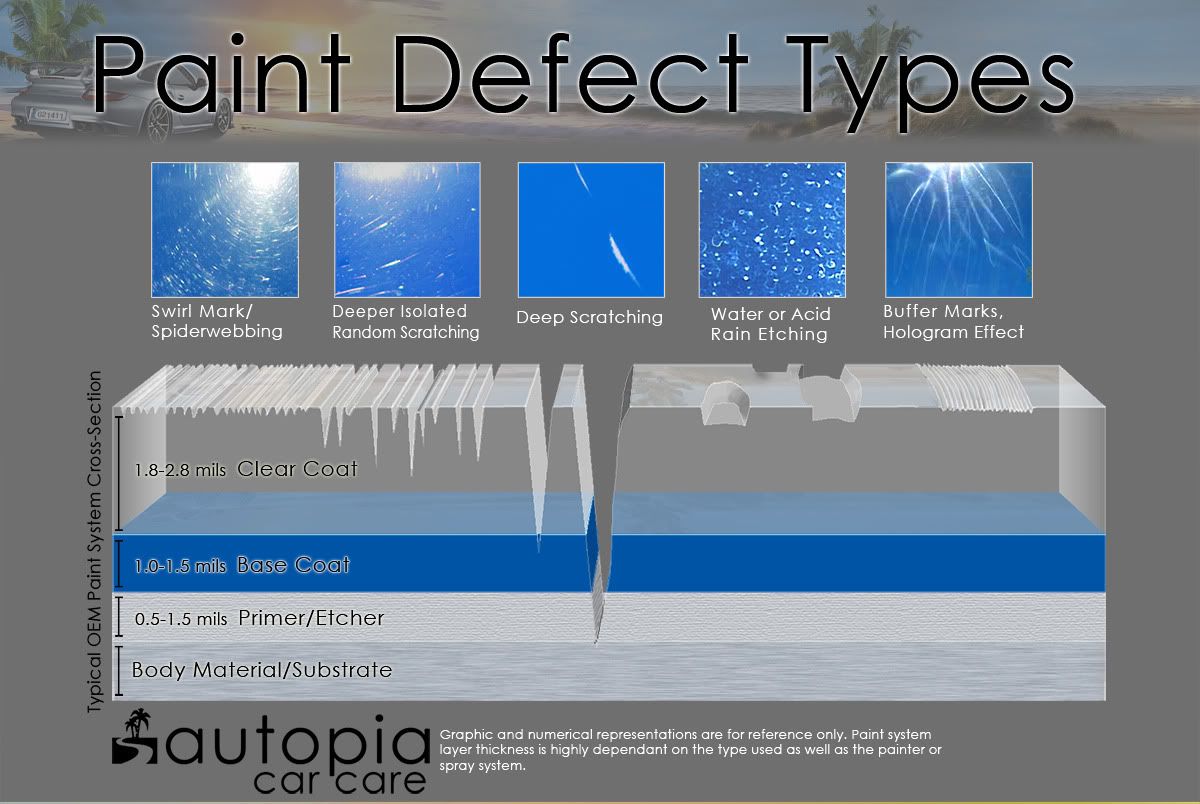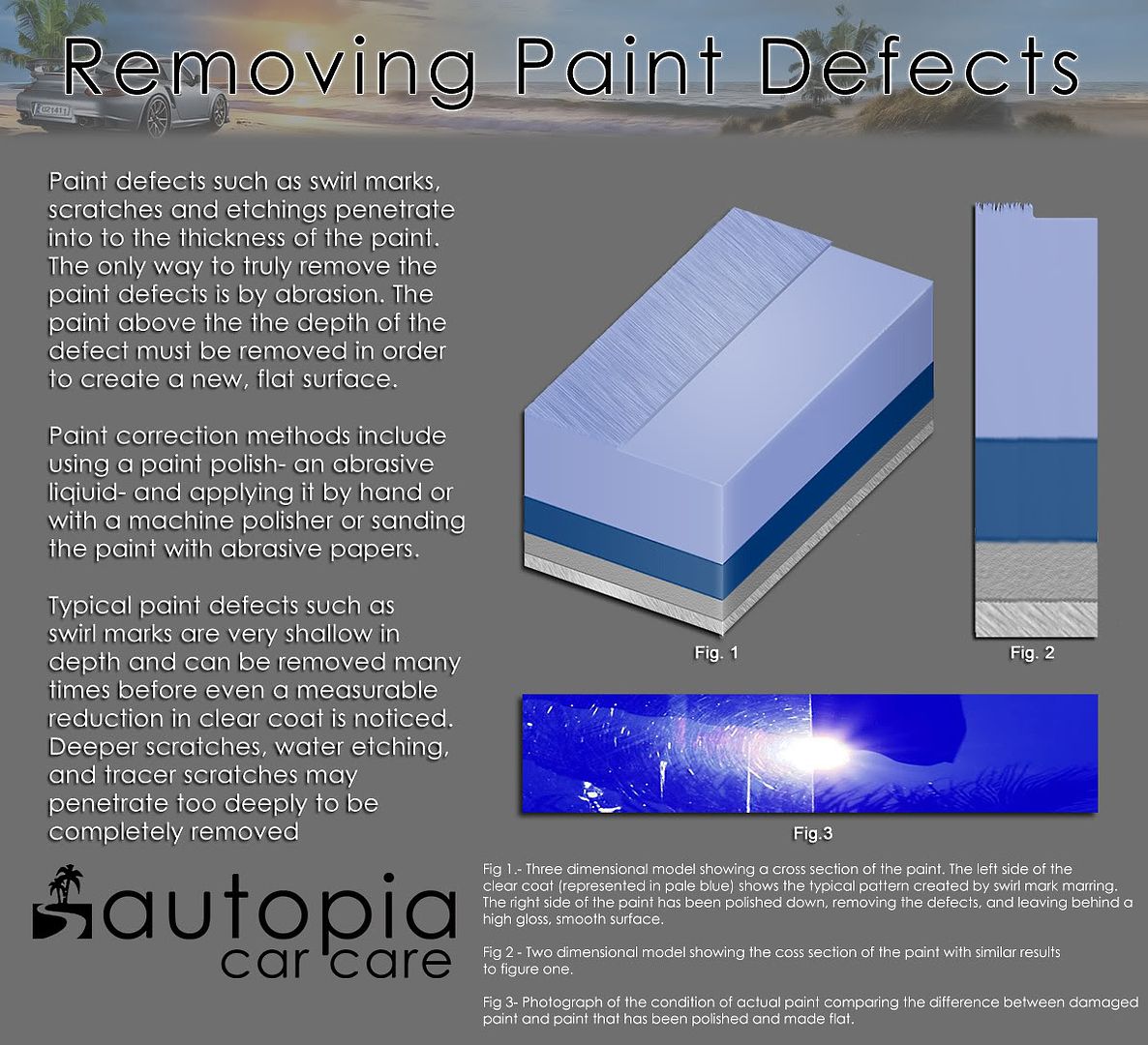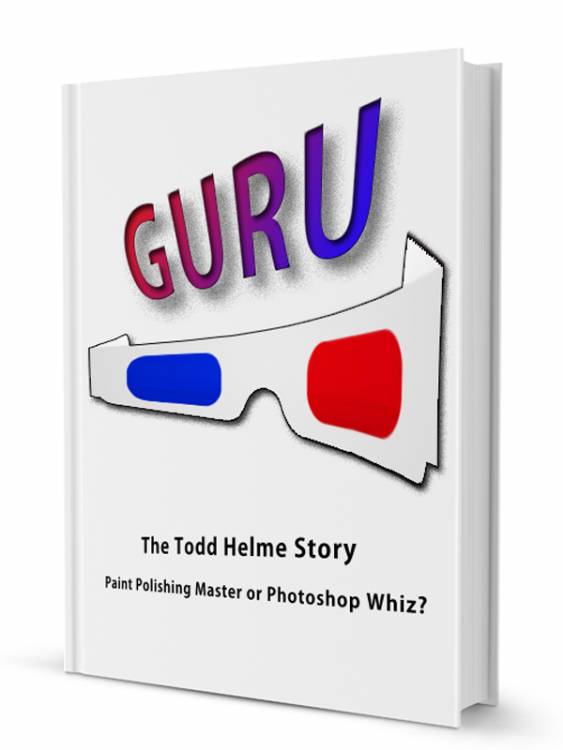Todd@RUPES
Just a regular guy
When a car is first painted the top coat is relatively smooth and reflects maximum light. Over time abrasion and environmental conditions transform the once smooth, level surface into a proverbial mountain range of varying textures that reduce the ultimate reflectivity of the paint. These changes in the surface are known as Paint Defects This occurs because changes in the angle of the paint, whether large or microscopic deflect light instead of reflect it evenly. Paint Defects are characterized by the by both the depth which they penetrate the surface, as well as the frequency and pattern which they occur.

Marring
Marring is often a term often used to frequently occurring, shallow paint defects.
Swirl Mark Marring- Swirl Mark marring is likely the most common type of defect. It is extremely shallow in depth and is very frequent in occurrence. Most swirl mark marring is wash induced and caused by incorrect washing and drying techniques. Because these paint defects are so easy to get and thus occur so frequently, they forum a circle pattern of scratches that reflect outwards from a central light source giving this marring it’s name sake: Swirl Marks or Spider Webbing.
Random Deep Marring is often wash induced but with a greater degree of force implicating more damage to the paint’s surface. A piece of grit stuck in a wash mitt or drying towel can cause isolated spots of deep marring; Washing a car with a shop brush or using an automated car wash can cause frequent spots of deep marring. Incorrect sanding of the vehicle’s paint can cause very deep marring also known as sanding tracers. Random Deep Marring occurs in different patterns and frequency, but is characterized by the depth of damage: Deep enough to see, but not deep enough to feel. In frequent deep marring is often referred to as Random Isolated Deeper Scratching or RIDS.
Scratching
Scratches are paint defects where a significant amount of paint has been removed and the defect is not only visible but can be felt to the touch. In general scratching/deep scratching penetrates too deeply into the paint’s surface to be completely removed, although the appearance may be lessened.
Etching
An etching is a type of paint defect that can very in depth and frequency, but creates a unique pattern dependent on how it is created. Etching is caused by chemical reaction on that paint’s surface that eats dissolves the surface at a fairly consistent rate of a relatively large area, creating depressions on the surface that appear like empty swimming pools. The most common forms of etching are from acid rain, acidic insect remains and bird bombs, and from the residual minerals found in water.
Machine Created Polish Marks
Holograms are extremely consistent, extremely shallow frequently occurring paint defects created by the machine polishing of paint. These defects are so frequent and shallow that they reflect light in their own unique pattern, creating a three dimensional appearance in the paint, hence the name hologramming. Hologramming is must often created by a high speed rotary polisher, allow dual action polishers can create a similar pattern if the pad is rotating fast enough. The pattern of ultra fine marks created by dual action polishers is often more random in nature and creates a pattern known as micro-marring or micro haze.
Paint Defect Removal
To remove a paint defect itself is impossible cause a paint defect is area where the paint has already been removed. To remove a paint defect means that all of the surrounding paint above the deepest part of the defect needs to be removed in order to create a more level surface. This new surface will be smooth and reflect maximum light. Because new cars are frequently damaged at the dealership, often this new fresh, smooth surface will improve the appearance of new vehicles dramatically as well.
The diagram below illustrates the difference between paint with paint defects and what removing them means.

Methods for Paint Defect Removal
By hand: Modern clear coats are much harder then their older, single stage counter parts. However modern technology increases have made it more possible to remove paint defects by hand. Keep in mind that the polishes used to remove paint evenly require a lot of work and this is the slowest method possible.
By machine: With the rise in popularity of Dual Action polishers, many enthusiast have taken to machine polishing their cars themselves. Machine polishing with a Dual Action is very safe and affords great results with a great margin of safety. Some enthusiasts and many professionals use a Rotary Polisher to polish paint. These powerful machines are capable of quickly removing the deepest marring marks but can also damage paint in the hands of an inexperienced user.
Removing Swirl Mark Marring: Swirl Mark Marring is very shallow by definition and usually requires only a light polishing step with a machine. Some harder paints may require a moderate polishing step followed by a finer polishing step for complete removal. These marks can often be removed by hand polishing.
Removing Random Deep Marring: Random Deep Marring can be the most frustrating paint defect to work with and usually requires several moderate to aggressive polishing steps for complete removal. Random Deep Marring is often the most difficult defect to diagnose with a visual inspection as it can occur frequently enough to look like typical Swirl Mark Marring. This is the case with vehicles that have been frequently washed with shop brushes, dirty rags, and dried with dirty towels or have been scrubbed clean at a drive thru car wash.
If these defects resemble typical swirl marks because of the frequency in which they occur they are often called Deep Swirls or Bad Swirls, and the detailer or enthusiastic has a long day a head of him.
If the Random Deep Marring occurs sporadically, it may not even be noticeable until the swirl marks have been removed. After polishing a couple of steps, the surface will show a dramatic improvement in gloss but deeper marks will remain visible, although infrequent. This pattern of occurring Random Deep Marring is also known as Random Isolated Deeper Scratching. The method of correction is the same regardless of the frequency and dependent on the depth.
Extreme cases of Random Deep Marring may require heavy compound polishing or wet sanding for complete removal.
Removing Scratching/Deep Scratching: Scratches can often be felt with your finger nail on the paint’s surface. This indicates that the defect has a significant amount of penetration and removal may not be completely possible or may require that too much paint is removed for its removal.
For scratching it is best to polish the edges of the scratch in order to blend the sharp edges and reduce the visibility of the scratch. This can be accomplished by hand or machine.
Removing Etching: Etching, because of the width of the defect, is difficult to remove. Complete removal often requires wet sanding the surface flat with a stiff backing plate because of a polishing pad’s tendency to travel into the defect itself. Deep etching often requires experience or a professional for removal.
Removing Buff Marks/Hologramming: Buffer marks are often caused by using too aggressive of a polish or pad as the last step in machine polishing, or using incorrect technique. Most buffer marks are extremely shallow and can be removed in a manner similar to removing swirl marks, requiring a finer polish and/or pad.

Marring
Marring is often a term often used to frequently occurring, shallow paint defects.
Swirl Mark Marring- Swirl Mark marring is likely the most common type of defect. It is extremely shallow in depth and is very frequent in occurrence. Most swirl mark marring is wash induced and caused by incorrect washing and drying techniques. Because these paint defects are so easy to get and thus occur so frequently, they forum a circle pattern of scratches that reflect outwards from a central light source giving this marring it’s name sake: Swirl Marks or Spider Webbing.
Random Deep Marring is often wash induced but with a greater degree of force implicating more damage to the paint’s surface. A piece of grit stuck in a wash mitt or drying towel can cause isolated spots of deep marring; Washing a car with a shop brush or using an automated car wash can cause frequent spots of deep marring. Incorrect sanding of the vehicle’s paint can cause very deep marring also known as sanding tracers. Random Deep Marring occurs in different patterns and frequency, but is characterized by the depth of damage: Deep enough to see, but not deep enough to feel. In frequent deep marring is often referred to as Random Isolated Deeper Scratching or RIDS.
Scratching
Scratches are paint defects where a significant amount of paint has been removed and the defect is not only visible but can be felt to the touch. In general scratching/deep scratching penetrates too deeply into the paint’s surface to be completely removed, although the appearance may be lessened.
Etching
An etching is a type of paint defect that can very in depth and frequency, but creates a unique pattern dependent on how it is created. Etching is caused by chemical reaction on that paint’s surface that eats dissolves the surface at a fairly consistent rate of a relatively large area, creating depressions on the surface that appear like empty swimming pools. The most common forms of etching are from acid rain, acidic insect remains and bird bombs, and from the residual minerals found in water.
Machine Created Polish Marks
Holograms are extremely consistent, extremely shallow frequently occurring paint defects created by the machine polishing of paint. These defects are so frequent and shallow that they reflect light in their own unique pattern, creating a three dimensional appearance in the paint, hence the name hologramming. Hologramming is must often created by a high speed rotary polisher, allow dual action polishers can create a similar pattern if the pad is rotating fast enough. The pattern of ultra fine marks created by dual action polishers is often more random in nature and creates a pattern known as micro-marring or micro haze.
Paint Defect Removal
To remove a paint defect itself is impossible cause a paint defect is area where the paint has already been removed. To remove a paint defect means that all of the surrounding paint above the deepest part of the defect needs to be removed in order to create a more level surface. This new surface will be smooth and reflect maximum light. Because new cars are frequently damaged at the dealership, often this new fresh, smooth surface will improve the appearance of new vehicles dramatically as well.
The diagram below illustrates the difference between paint with paint defects and what removing them means.

Methods for Paint Defect Removal
By hand: Modern clear coats are much harder then their older, single stage counter parts. However modern technology increases have made it more possible to remove paint defects by hand. Keep in mind that the polishes used to remove paint evenly require a lot of work and this is the slowest method possible.
By machine: With the rise in popularity of Dual Action polishers, many enthusiast have taken to machine polishing their cars themselves. Machine polishing with a Dual Action is very safe and affords great results with a great margin of safety. Some enthusiasts and many professionals use a Rotary Polisher to polish paint. These powerful machines are capable of quickly removing the deepest marring marks but can also damage paint in the hands of an inexperienced user.
Removing Swirl Mark Marring: Swirl Mark Marring is very shallow by definition and usually requires only a light polishing step with a machine. Some harder paints may require a moderate polishing step followed by a finer polishing step for complete removal. These marks can often be removed by hand polishing.
Removing Random Deep Marring: Random Deep Marring can be the most frustrating paint defect to work with and usually requires several moderate to aggressive polishing steps for complete removal. Random Deep Marring is often the most difficult defect to diagnose with a visual inspection as it can occur frequently enough to look like typical Swirl Mark Marring. This is the case with vehicles that have been frequently washed with shop brushes, dirty rags, and dried with dirty towels or have been scrubbed clean at a drive thru car wash.
If these defects resemble typical swirl marks because of the frequency in which they occur they are often called Deep Swirls or Bad Swirls, and the detailer or enthusiastic has a long day a head of him.
If the Random Deep Marring occurs sporadically, it may not even be noticeable until the swirl marks have been removed. After polishing a couple of steps, the surface will show a dramatic improvement in gloss but deeper marks will remain visible, although infrequent. This pattern of occurring Random Deep Marring is also known as Random Isolated Deeper Scratching. The method of correction is the same regardless of the frequency and dependent on the depth.
Extreme cases of Random Deep Marring may require heavy compound polishing or wet sanding for complete removal.
Removing Scratching/Deep Scratching: Scratches can often be felt with your finger nail on the paint’s surface. This indicates that the defect has a significant amount of penetration and removal may not be completely possible or may require that too much paint is removed for its removal.
For scratching it is best to polish the edges of the scratch in order to blend the sharp edges and reduce the visibility of the scratch. This can be accomplished by hand or machine.
Removing Etching: Etching, because of the width of the defect, is difficult to remove. Complete removal often requires wet sanding the surface flat with a stiff backing plate because of a polishing pad’s tendency to travel into the defect itself. Deep etching often requires experience or a professional for removal.
Removing Buff Marks/Hologramming: Buffer marks are often caused by using too aggressive of a polish or pad as the last step in machine polishing, or using incorrect technique. Most buffer marks are extremely shallow and can be removed in a manner similar to removing swirl marks, requiring a finer polish and/or pad.
Last edited:

